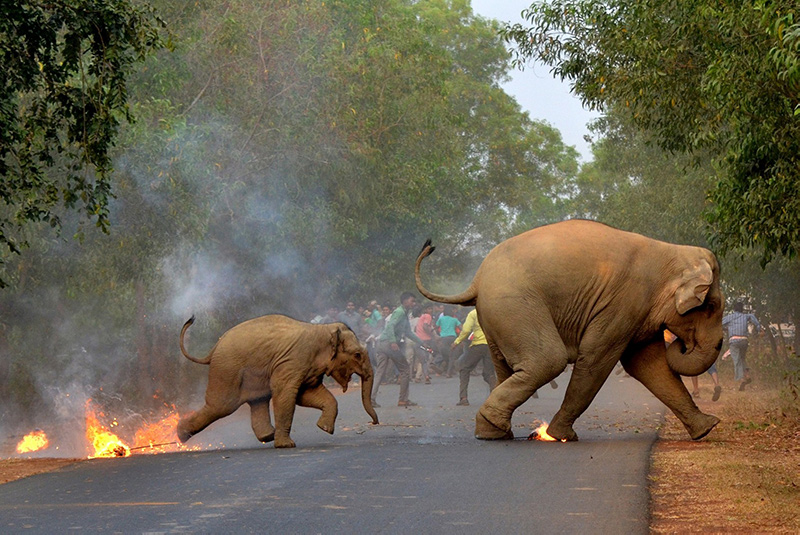Human-Elephant Conflict
The Asian Elephant (Elephas maximus), National Heritage Animal of India, is accorded the highest protection as per Schedule I of the Wildlife Protection Act, 1972 and is the largest living mammal in the country.
An animal, the size of an elephant requires large contiguous tracts of forests to survive and sustain the viability of its population. Sadly, relentless intrusion into wild habitats has fragmented the once widespread forests into small, degraded patches of green cover. These fragments alone cannot sustain elephants, who migrate from one protected area to another using their traditional migration routes or corridors.
Unfortunately, numerous obstructions hamper the free movement of elephants along these corridors – roads, railways, industries, mines, brick kilns, hotels and resorts. As a result, the pachyderms inadvertently venture into farmlands and human settlements adjoining protected areas to circumvent these obstructions. Furthermore, the lack of adequate fodder in forests left degraded by illegal logging and monoculture compels elephants to raid crops, bringing them into conflict with human communities.

This conflict has reached alarming proportions in West Bengal. In 2017-18 alone, elephants killed 66 people and injured an additional 98. On the other hand, about 26 elephants died of unnatural causes in West Bengal in 2020. Yet, despite the immediate need for intervention from implementing authorities, human-elephant conflict continues to either be overlooked or addressed using haphazard methods that are grossly unscientific and counterproductive.
Promoting Human-Elephant Coexistence In South Bengal

In 2024, HEAL launched the ‘Elephant Conservation Program to Promote Human-Elephant Coexistence’ in Jhargram district, targeting the drivers of human-elephant conflict in South Bengal. The program addresses three critical challenges: resource-poor habitats for elephants, crop depredation in farmer-owned paddy fields, and inadequate safety measures against elephant intrusions in human settlements. Through a comprehensive, multi-pronged approach that prioritizes the well-being of both elephants and local communities, the program aims to mitigate negative interactions and foster a harmonious coexistence between humans and elephants in the region.
Action against the malpractice of ‘Hulla’
HEAL advocates the use of non-intrusive methods to manage human-elephant conflict. In 2018, we supported a litigation filed in the Supreme Court against ‘hulla drives’ – a state-sponsored mob of fire torch-throwing rowdy miscreants who benefit from scaring and traumatising elephant herds while inflicting further economic damage under the garb of protecting crops and helping farmers. We photo and video documented the derogatory practice that served as crucial evidence in the case.
Jongol Sathi Initiative to foster human-elephant coexistence

In collaboration with the Wildlife Trust of India, HEAL launched the ‘Jongol Sathi’ (Friends of the forest) initiative intending to sensitise local communities about the appropriate ways to manage elephants. Jongol Sathi are a group of 20 volunteers from Santbaki, Jhargram, a district with a significant elephant presence. The team was trained in monitoring elephants and managing conflict situations without resorting to harmful, intrusive ways. Utilising these methods would ensure the safety of elephants while facilitating peaceful coexistence between community members and the resident elephants.
Public Interest Litigation for Safe Passage of elephants
Several studies have identified traditional migration routes of elephants in India along which they traverse between protected areas. Among them, Northern West Bengal has 14 intrastate elephant corridors and southern West Bengal has 3 interstate corridors.
Various impediments threaten the safe passage of elephants along these traditional migration routes. Corridors are being rampantly diverted for infrastructure development and agriculture. This rapid change in land use patterns has resulted in an upward trend in the unnatural death of elephants. These happen directly through human actions, such as deliberate electrocution, poisoning, or poaching, or indirectly through train and road accidents, accidental electrocution, etc.
Therefore, in 2019, HEAL filed a PIL in the Calcutta High Court asking for directives on the state of West Bengal to identify, demarcate and protect traditional and recent elephant corridors. The petition seeks to make providing safe passage to elephants a priority for the state government. Further, it urges the state to take immediate effective steps to formally recognise, restore and remove encroachments from elephant corridors to ensure the long-term survival and well-being of our National Heritage Animal.




